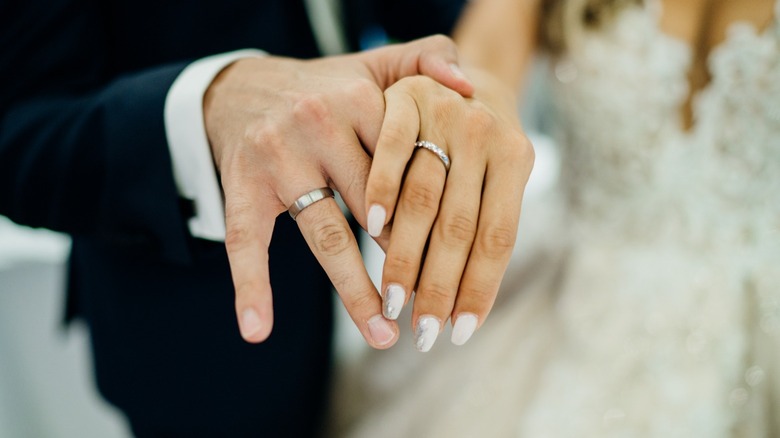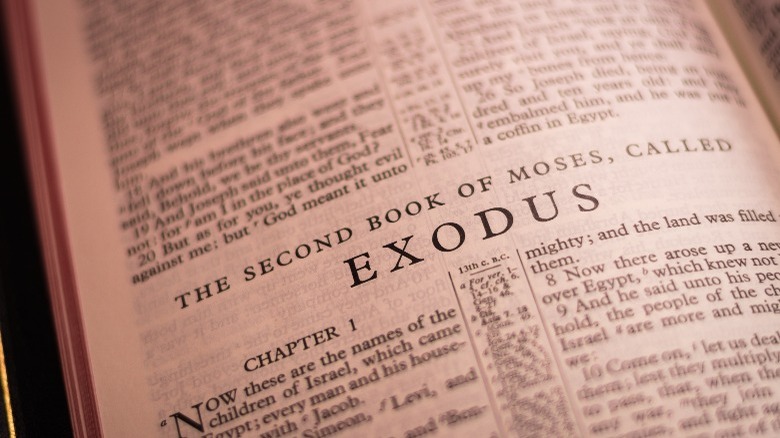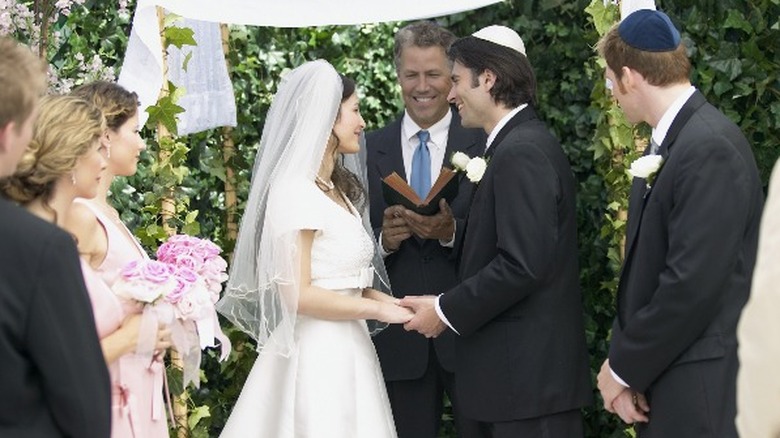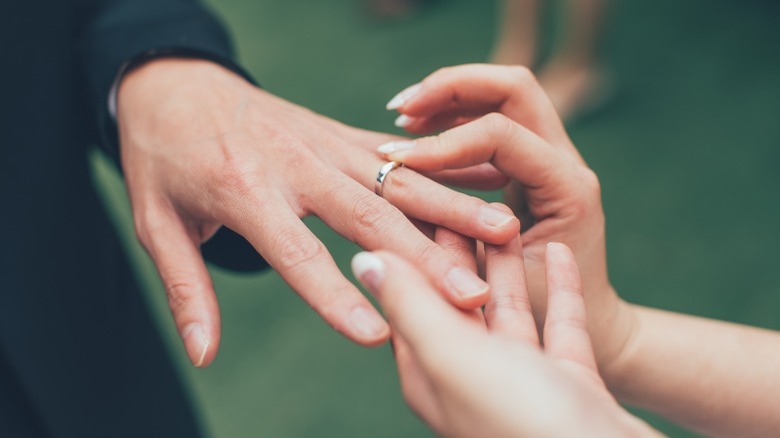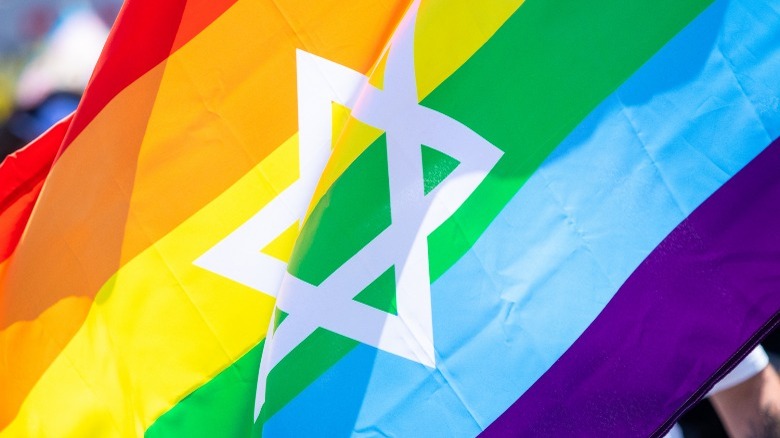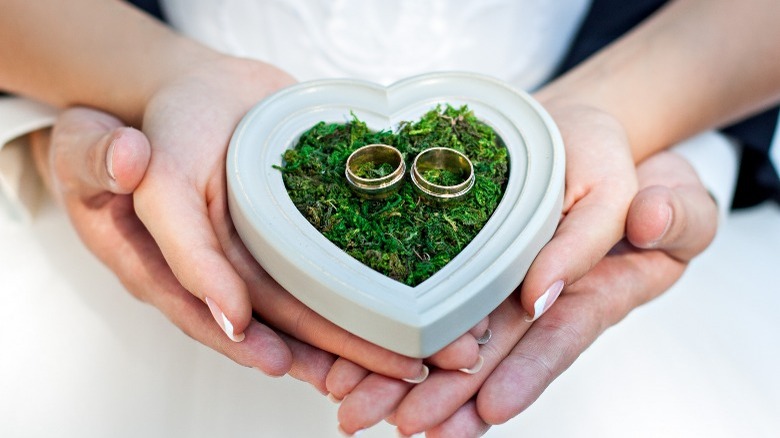What Jewish Custom Says About The Tradition Of Wedding Rings
Whereas the Jewish religion is thousands of years old, Jewish weddings have only included rings for around 1,400 years, according to wedding website The Knot. Chabad notes that there are no references to wedding rings in the Talmud, which outlines Jewish laws. Instead, Jewish law states that a marriage can be contracted in one of three ways: through a contract, through sex, or through the giving of something valuable (via Learn Religions). Over time, the third option became the most common, and rings became the item most often used. However, in the past, other items were given instead, including prayer books, fruit, property deeds, and special wedding coins. The ring or other item is a gift the groom gives the bride. Her acceptance of the gift indicates her consent to marry him. Without that consent, they can't be married.
According to Halakhah, or Jewish law, wedding rings must be plain metal with no gemstones (via Chabad). Learn Religions explains that this is so the ring's value will be clear to the bride, and she won't be accepting it under false pretenses. It should be more valuable than a prutah, an ancient type of coin worth about four-fifths of a modern penny. This rule allowed even poor couples to marry (via Jewish Celebrations). The ring must also belong to the groom, so that he has a right to give it away, per Reform Judaism.
The symbolism of the ring
Jewish people may have adopted the tradition of wedding rings from another culture; in fact, their use is first documented in Egypt around 3,000 years ago, per Chicago Jewish News. However, Jewish people have attributed their own symbolic meanings to the rings. According to Jewish Celebrations, there are many Biblical references to the importance of rings. Specifically, golden rings are described as part of the Tabernacle in the Book of Exodus (via My Jewish Learning).
Both the circular shape of the rings and their lack of gemstones or piercings represent the unbroken bond of marriage, per The Knot. Plain, unadorned rings also mean there's less disparity between rich and poor couples. On the other hand, gold is often used for Jewish wedding rings because it's the most valuable metal, according to Jewish Celebrations. The Garden of Eden contained gold, so golden wedding rings can also symbolize new creation — the new union between the couple and the possibility of having children. My Jewish Learning also suggests that since gold rarely becomes tarnished, gold rings can suggest a marriage that will continue to be endure long into the future.
The ring in Jewish wedding ceremonies
A traditional Jewish wedding consists of two parts: the kedushin, which means "sacred action" — the official betrothal — and the nisuin, or "elevation" — the formal start of the marriage (via Learn Religions). The two parts now often happen on the same day, and the ring is involved in the first part. According to Chabad, the wedding must include witnesses, who must see the ring and acknowledge its value. The groom must also confirm the value to the rabbi and specify that the ring is his.
After this, the groom places the ring on the bride's right index finger and says, "Harei at mekudeshet li b'taba'at zo kedat Moshe viyisrael" ("Behold you are sanctified to me according to the laws of Moses and Israel"), via The Schechter Institutes. In accepting the ring, the bride agrees to follow the ketubah, the rules of marriage, per My Jewish Learning. The right hand may be used for one of several reasons, including that it's the hand used for making oaths (via Learn Religions). However, many modern Jewish brides move their rings to their left hand after the ceremony because of Western customs.
Jewish men and wedding rings
There are three main branches of Judaism: Orthodox, Conservative, and Reform. Each does things a little differently. However, where wedding rings are concerned, many of the customs are the same. This includes the requirements for the ring — its shape and design and who owns it — as well as the symbolism it holds. The groom typically says the same "harei" declaration in each branch of Judaism (via Jewish Celebrations).
There are, however, different perspectives on whether men should receive and wear wedding rings. The Jewish Chronicle explains the debate. Traditionalists point out that it isn't customary for Jewish men to wear wedding rings; they're merely imitating another culture, which is against Halakhah, specifically a category called chukkat hagoy based on a verse from Leviticus 18, which forbids imitating non-Jewish culture just for the sake of it.
On the other hand, a more modern perspective is that a man wearing a wedding ring is showing loyalty to his wife and avoiding any awkward questions. Zionist Orthodox Rabbi David Stav suggests men should wear wedding rings if their wives ask them to, and that it can be helpful when living among non-Jewish people (via The Jewish Chronicle).
Are double-ring exchanges acceptable?
This debate includes a question about whether men who do wear rings should receive them during the wedding ceremony itself. Jewish Celebrations, giving the Conservative perspective, notes that it's not a Jewish tradition for the man to receive a ring, and that the bride giving the groom a ring could be seen as ungratefully returning the gift he's just given her. However, the website's article on the Reform perspective suggests a double-ring exchange is now normal and acceptable.
Proponents of a double-exchange argue that it's more inclusive of same-sex couples (via My Jewish Learning). Even in a wedding with opposite sexes, it puts the bride and groom on more equal footing, per Reform Judaism.
Conservative Rabbi Professor David Golinkin, writing for The Schechter Institutes, doesn't agree with most of the arguments against a double-ring exchange. He says he doesn't view it as an attempt to imitate non-Jewish culture or to change the Torah, nor will it cause anyone to forget the rules of marriage. He quotes other Conservative and Orthodox rabbis who say the bride giving a ring doesn't negate the legality of the marriage, so it should be all right.
Options for a double-ring exchange
Double-ring exchanges are becoming more common, but there are still different ways of doing it. One option is for the bride to give her ring immediately after the groom gives his and to say the same phrase he does, but adapted with male pronouns (via My Jewish Learning). However, Jewish law says official betrothal (kiddushin) can only occur through the groom gifting a ring to the bride, per Rabbi Professor David Golinkin, writing for The Schechter Institutes. Therefore, Jewish Celebrations explains, the second ring is often given simply as a "token of love," nothing official.
Golinkin says some rabbis fear the difference won't be obvious, but he feels it can easily be explained in the course of the ceremony. Other options he suggests: she can give the ring at another point in the ceremony, or after it, to avoid confusion. She can also use any of a number of other phrases besides the "harei" declaration. Both Golinkin and Jewish Celebrations mention an often-used verse from Song of Songs (aka the Song of Solomon, per Britannica): "I am my beloved's, and my beloved is mine." Golinkin makes other suggestions, too, like a verse from the Song of Solomon: "Let me be a seal upon your heart, like the seal upon your arm"; or one from Hosea: "I will betroth you unto Me forever." He also says the bride could write something of her own. In any case, he and other Jewish authorities support the idea of a wedding ceremony that's more egalitarian, and in which the bride plays a more active part.
